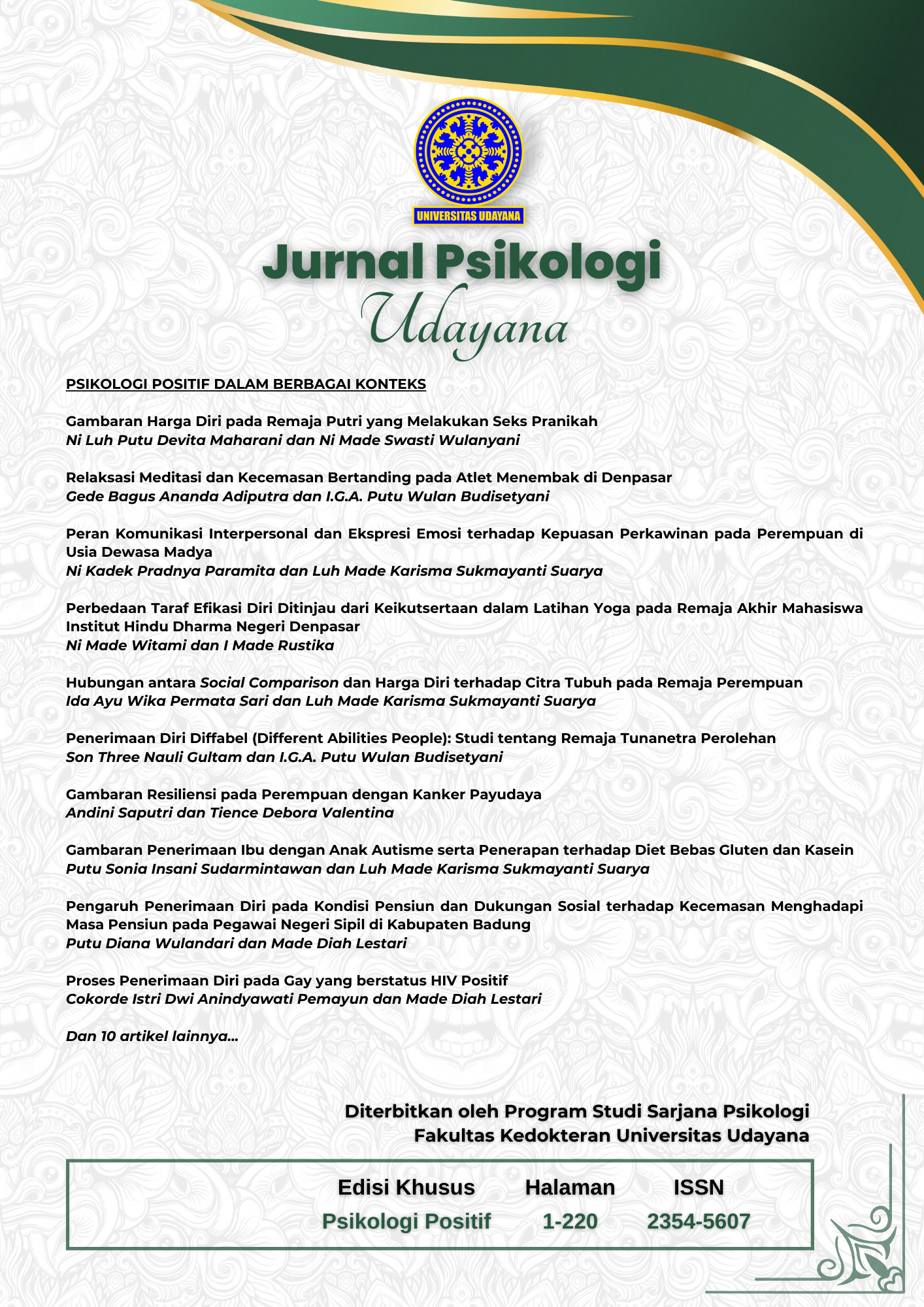DINAMIKA HARAPAN IBU TUNGGAL YANG MEMILIKI ANAK DENGAN GANGGUAN AUTISME PADA FASE DEWASA AWAL
Abstract
Menjadi ibu tunggal yang memiliki anak dengan gangguan autisme dapat menyebabkan cemas dan depresi maternal
(Orsmond dkk., 2007). Seiring bertambahnya usia, stresor ibu tunggal juga meningkat. Hal tersebut dapat memengaruhi
kesejahteraan hidup ibu tunggal dan kualitas pengasuhan. Kondisi patologis yang berlanjut dapat mengarah pada
pemikiran kematian dan kecenderungan pengabaian pengasuhan (Cox dkk., 2015). Salah satu cara yang dapat dilakukan
ibu tunggal untuk meminimalisir kondisi patologis adalah dengan mengembangkan harapan (Monsson, 2010). Harapan
didefinisikan sebagai kondisi mental yang positif tentang kemampuan untuk mencapai tujuan di masa mendatang (Lopez
& Snyder, 2003). Penelitian ini bertujuan untuk melihat dinamika harapan ibu tunggal yang memiliki anak dengan
gangguan autisme pada fase dewasa awal.Penelitian kualitatif ini menggunakan pendekatan studi kasus. Teknik
pengambilan sampel adalah sampel bertujuan. Responden merupakan ibu tunggal, memiliki anak dengan gangguan
autisme pada fase dewasa awal. Data dikumpulkan dengan melakukan wawancara, observasi, dan penghimpunan
dokumen. Data yang terkumpul dianalisis menggunakan sistem koding, terdiri dari koding terbuka, aksial, dan selektif
(Strauss, 2003). Hasil dari penelitian ini menunjukkan bahwa dinamika harapan terdiri dari fase penurunan level harapan,
fase membangun harapan, dan proses harapan. Kondisi anteseden dan faktor harapan memengaruhi dinamika harapan
dalam penelitian ini.
Kata kunci: dinamika harapan, ibu tunggal, gangguan autisme pada fase dewasa awal
Downloads
References
Asmika, Andarini, S., & Rahayu, R.P. (2006). Hubungan motivasi orangtua untuk mencapai kesembuhan anak dengan tingkat pengetahuan tentang penanganan anak penyandang autisme dan spektrumnya. Jurnal Kedokteran Brawijaya, 22(2)
Christie, J. (2014). Struggling single mother, 40, left suicide note saying she could no longer cope caring for severely autistic son, 16, before killing him and then herself. Diakses pada 12 Februari 2017 dari www.dailymail.co.uk/news/article-2613443/Struggling-single-mother-40-left-suicide-note-saying-she-could-no-longer-cope-caring-for-severely-autistic-son-16-before-killing-him-and-then-herself.html.
Cox, C., Eaton, S., Ekas, N., & Enkevort, E. V. (2015). Death concerns and psychological well-being in mothers of children with autism spectrum disorder. Research in Developmental Disabilities, 229-238.Tersedia di http://dx.doi.org/10.1016/j.ridd/2015.07.029
Davidson, G. C., Neale, J. M., & Kring, A. M. (2012). Psikologi abnormal (edisi kesembilan). Depok: PT Rajagrafindo Persada.
Duchovic, C. A., Gerkensmeyer, J. A., & Wu, J. (2009). Factors associated with parental distress. Jurnal of Child and Adolescent Psychiatric Nursing, 22(1): 40-48
Dyches, T., Christensen, R., Harper, J., Mandleco, B., & Roper, S. (2015). Respite care for single mothers of children with autism spectrum disorders. Journal of Autism and Developmental Disorders, doi: 10.1007/s10803-015-2618-z, 2-36.
Hartmann, A.L. (2012). Autism and its impact on families. (Clinical research paper, University of Saint Thomas, Minnesota). Diakses dari http://sophia.stkate.edu
Hashim, I., Azmawati, A., & Endut, N. (2015). Stress, roles and responsibilities of single mothers in Malaysia. SHS Web Conference, 18, doi: 10.1051/shsconf/20151803003, 1-8.
Hellman, C., Worley, J., & Munoz, R. (2014). A primer on hope as a theory of change for human service providers. Hope as A Coping Resource, 1-15.
Himpunan Psikologi Indonesia (HIMPSI). (2010). Kode etik psikologi Indonesia. Jakarta: Himpunan Psikologi Indonesia.
Horton, T., dan Wallander, J. (2001). Hope and social support as resilience factors against psychological distress of mothers who care for children with chronic physical conditions. Rehabilitation Psychology, 382-399.
Lopez, S. (2009). The encyclopedia of positive psychology. West Sussex, UK: Wiley-Blackwell.
Lopez, S., & Snyder, C. (2003). Positive psychological assessment: A handbook of models and measures. Washington DC: American Psychological Association.
Mann, A. (2013). The experiences of mothers of children with autism in Jamaica: An exploratory study of their journey. (Dissertation, University of South Florida, Florida). Diakses dari http://scholarcommons.usf.edu/cgi/viewcontentcgi?article
Moleong, L. J. (2004). Metodologi penelitian kualitatif (edisi revisi). Bandung: PT Remaja Rosdakarya Offset.
Monsson, Y. (2010). The effects of hope on mental health and chronic sorrow in parents of children with autism spectrum disorder. (Doctoral Dissertation, University of Kansas, Kansas). Diakses dari https://kuscholarworks.ku.edu/ bitstream/handle/1808/6981/Monsson_ku_0099D_10980_DATA_1.pdf?sequence=1
Orsmond, G. I., Lin, L-Y., & Seltzer, M. M. (2007). Mothers of adolescents and adults with autism: Parenting multiple children with disabilities. Intelectual and Developmental Disabilities, 45(4): 257-270.
PEKKA. (2015). Pemberdayaan perempuan kepala keluarga. Diakses pada 12 Februari 2017 dari http://pekka.or.id/index.php/id/tentang-kami/276/pemberdayaan-perempuan-kepala-keluarga-pekka.html
Pratiwi, P.I. (2016). Harapan ibu sebagai orangtua tunggal yang memiliki anak dengan gangguan autisme berusia dewasa awal. (Studi Kasus Program Sarjana, Universitas Udayana, Denpasar). Dokumen tidak dipublikasikan.
Rohmah, I. A. 2013. Kualitas hidup pada ibu yang memiliki anak dengan gangguan spektrum autistik. (Skripsi, Universitas Islam Negeri Sunan Kalijaga, Yogyakarta). Diakses dari http://digilib.uin-suka.ac.id
Santoso, G., & Royanto, L. (2009). Teknik penulisan laporan penelitian kualitatif. Depok: LPSP3 UI.
Smith, L., Hong, J., Seltzer, M., Greenberg, J., Almeida, D., & Bishop, S. (2009). Daily experiences among mothers of adolescents and adults with autism spectrum disorder. Autism Developmental Disorder. doi: 10.1007/s10803-009-0844-y
Snyder, C.R., Harris, C., Anderson, J.R., Holleran, S.A., Irving, L.M., Sigmon, S.T., dkk. (1991). The will and the ways: Development and validation of an individual-differences measure of hope. Journal of Personality and Social Psychology, 60(4), 570-585
Snyder, C.R., Sympson, S.C., Ybasco, F.C., Borders, T.F., Babyak, M.A., dan Higgins, R.L. (1994). Development and validation of the state of hope scale. Journal of Personality, in press
Snyder, C.R. (1995). Conceptualizing, measuring, and nurturing hope. Journal of Counseling and Development, 73(3), 355-360.
Snyder, C.R. (2002). Hope theory: Rainbows in the mind. Psychological Inquiry, 13(4), 249-275.
Strauss, A. (2003). Qualitative analysis for social scientists. Cambridge: Cambridge University Press.
Sugiyono. (2014). Metode penelitian kombinasi (mixed methods). Bandung: Alfabeta.
Totsika, V., Hastings, R., & Emerson, E. (2011). Behavior problems at 5 years of age and maternal mental health in autism and intelectual disability. Journal of Abnormal Child Psychology 39(8), 1137-1147.
Truitt, M., Biesecker, B., Capone, G., Bailey, T., & Erby, L. (2012). The role of hope in adaptation to uncertainty: The experience of caregivers of children with Down Syndrome. Patien Educational Counseling. doi: 10.1016/j.pec.2011.08.015, 87(2)
Weiss, J., Wingsiong, A., & Lunsky, Y. (2014). Defining crisis in families of individuals with autism spectrum disorders. Autism 18(8). doi: 10.1177/1362361313508024, 985-995
Yin, R. (2003). Case study research: design and methods (3rd Ed.). California: Sage Publications Inc.
Authors who publish with this journal agree to the following terms:
- Authors retain copyright and grant the journal right of first publication with the work simultaneously licensed under a Creative Commons Attribution-ShareAlike 4.0 International License that allows others to share the work with an acknowledgement of the works authorship and initial publication in this journal.
- Authors are able to enter into separate, additional contractual arrangements for the non-exclusive distribution of the journals published version of the work (e.g., post it to an institutional repository or publish it in a book), with an acknowledgement of its initial publication in this journal.
- Authors are permitted and encouraged to post their work online (e.g., in institutional repositories or on their website) prior to and during the submission process, as it can lead to productive exchanges, as well as earlier and greater citation of published work (See The Effect of Open Access).













